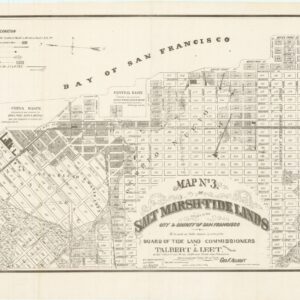Never-folded mid-19th century map of San Francisco by Britton and Rey.
Map of the City of San Francisco Published by Britton & Rey
Out of stock
Description
One of the earliest maps of San Francisco published in the city itself.
Finely detailed map of the populated areas of San Francisco, oriented to the west. The map extends west to Divisadero; south to Alta.
Since there are no folds in this copy, it was undoubtedly a separate issued. It has a neatly printed number 55 on a small piece of paper affixed in the lower margin. One interesting feature is the tracing of the original shoreline of San Francisco, showing just how much of the city is built on landfill.
The map documents a momentous time for both the city in particular and the United States in general — what Barbara Berglund calls “the emergence of a new urban society on the western frontier of the country’s landed empire.” In the years prior to the publication of this map, San Francisco was a true boom-town, having grown from a sleepy village into a sizable city in about one year. In the summer and fall of 1848, after the discovery of gold in the Sierra Nevada foothills, the town of about 1,000 was nearly depopulated as its residents literally ran for the hills in search of gold. Two years later, after the 1849 Gold Rush brought gold seekers from all over the world, it had grown to a city of over 25,000—the largest on the Pacific coast of the Americas.
Britton & Rey were located at the corner of Montgomery St. and Commercial St. between 1854 and 1858.
Cartographer(s):
Britton & Rey (1852 – 1906) was a lithographic printing firm based in San Francisco and founded by Joseph Britton and Jacques Joseph Rey in 1852. Especially during the second half of the 19th century, Britton and Rey became the leading lithography firm in San Francisco, and probably California. Among their many publications were birds-eye-views of Californian cities, depictions of the exquisite landscapes, stock certificates, and no least maps. While Rey was the primary artist, Britton worked not only as the main lithographer but was essentially also the man running the business. In addition to their own material, the firm reproduced the works of other American artists like Thomas Almond Ayres (1816 – 1858), George Holbrook Baker (1824 – 1906), Charles Christian Nahl (1818 – 1878), and Frederick August Wenderoth (1819 – 1884). Following Rey’s death in 1892 Britton passed the form on to Rey’s son, Valentine J. A. Rey, who ran it until the great earthquake and fire of 1906 destroyed most of the company’s assets.
Joseph Britton (1825 – July 18, 1901) was a lithographer and the co-founder of the prominent San Francisco lithography studio Britton and Rey. He was also a civic leader in San Francisco, serving on the Board of Supervisors and helping to draft a new city charter. In 1852, he became active in lithography and publishing, first under the name ‘Pollard and Britton,’ and then ‘Britton and Rey,’ a printing company founded with his friend and eventual brother-in-law Jacques Joseph Rey. Britton and Rey became the premier lithographic and engraving studio of the Gold Rush era, producing letter sheets, maps, and artistic prints.
Jacques Joseph Rey (1820 – 1892) was a French engraver and lithographer born in the Alsatian town of Bouxwiller. At the age of about 30, he emigrated to America, eventually settling in California. Here, he soon entered into a partnership with local entrepreneur and civic leader Joseph Britton. Three years later, Rey also married Britton’s sister, allowing his business partner and brother-in-law Britton to live in their house with them. Rey and Britton were not only an important part of the San Francisco printing and publishing scene but also owned a plumbing and gas-fitting firm. In the early years, both men would sometimes partner up with others on specific projects, but by the late 1860s, their partnership was more or less exclusive.
Condition Description
Never folded. Excellent.
References
Harry T. Peters, California on Stone (New York, NY, 1976).








![5-sheet set showing San Francisco’s post-1906 earthquake water supply [SF’s first fireboat!]](https://neatlinemaps.com/wp-content/uploads/2022/03/NL-01375-sheet-4_thumbnail-scaled-300x300.jpg)
![5-sheet set showing San Francisco's post-1906 earthquake water supply [SF's first fireboat!]](https://neatlinemaps.com/wp-content/uploads/2022/03/NL-01375-sheet-4_thumbnail-scaled.jpg)